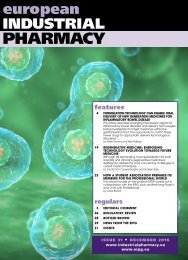PHARMACY
eip26-sep15
eip26-sep15
- No tags were found...
You also want an ePaper? Increase the reach of your titles
YUMPU automatically turns print PDFs into web optimized ePapers that Google loves.
IN SILICO CLINICAL<br />
TRIALS: DREAM OR<br />
CERTAINTY?<br />
by Marco Viceconti, Adriano Henney, Edwin Morley-Fletcher and<br />
Martina Contin<br />
The astronomical cost of bringing medical products to<br />
market has stalled the development of drugs,<br />
crippling healthcare budgets and, for rare diseases,<br />
making new treatments the preserve of the rich.<br />
However, this September the Avicenna Consortium,<br />
tasked by the European Commission to investigate how<br />
computer modelling might mitigate the cost of clinical<br />
trials, released its Roadmap – ‘In Silico Clinical Trials:<br />
How Computer Simulation Will Transform The Biomedical<br />
Industry’.<br />
Marco Viceconti is Professor of Biomechanics in the Department of Mechanical<br />
Engineering at the University of Sheffield, UK and Professor Associate at the<br />
Department of Human Metabolism. He is the Scientific Director of the University of<br />
Sheffield’s Insigneo Institute for in silico Medicine, a joint initiative between the<br />
University of Sheffield and the Sheffield Teaching Hospital NHS Foundation Trust.<br />
Adriano Henney, Director of Obsidian Biomedical Consulting Ltd, worked for 13 years<br />
in one of the top five multinational pharmaceutical companies before becoming<br />
Programme Director of the German Virtual Liver Network, the largest Virtual<br />
Physiological Human (VPH) project running in Europe (http://www.virtual-liver.de). Dr<br />
Henney has directed this major German national flagship research programme<br />
focusing on modelling human liver physiology since 2010.<br />
Edwin Morley-Fletcher is President of Lynkeus srl, Italy and has over 25 years’<br />
experience in ebusiness. In the last 10 years, he has progressively focused on<br />
information and communications technology for health, managing some of the largest<br />
VPH projects, including MD-Paedigree, one of the three integrated projects funded in<br />
call 9.<br />
Martina Contin worked as Communication Manager in various VPH initiatives at the<br />
VPH Institute, Belgium, before taking the helm of the not-for-profit organisation that<br />
coordinates all VPH research worldwide. The organisation aims to ensure the VPH is<br />
fully realised, universally adopted and effectively used.<br />
Introduction<br />
The Roadmap is the culmination of<br />
2 years’ work involving contributions<br />
from over 500 international experts<br />
at five events held across Europe. It<br />
promises huge cost reductions in<br />
medical product development<br />
through the use of computer<br />
simulation.<br />
With the release of the Roadmap,<br />
the Avicenna project officially comes<br />
to an end. However, to ensure the<br />
ideas contained are taken forward<br />
and making its recommendations<br />
become a reality, a new organisation<br />
has been formed: the Avicenna<br />
Alliance – the Association for<br />
Predictive Medicine. This first<br />
partnership of pharmaceutical<br />
industrialists, medical device<br />
manufacturers, academic<br />
researchers and regulatory experts<br />
will aim to revolutionise the<br />
healthcare industry through the use<br />
of computer simulation.<br />
This September, the Avicenna<br />
Consortium, tasked by the European<br />
Commission to investigate how<br />
computer modelling might mitigate<br />
the cost of clinical trials, released its<br />
Roadmap: ‘In Silico Clinical Trials:<br />
How Computer Simulation Will<br />
Transform The Biomedical Industry’.<br />
This article describes the process<br />
and the future of the Avicenna<br />
vision.<br />
The Roadmap<br />
Approaching the investigation of<br />
the potential impact of in silico<br />
clinical trials, the Avicenna<br />
Consortium brought together a<br />
range of experts from around the<br />
world – academics, clinicians,<br />
industrialists, patients’ advocates,<br />
computer experts, regulators and<br />
safety experts. Over 2 years, the<br />
consortium organised five events in<br />
different European cities,<br />
conducted dozens of experts’<br />
interviews, and used state-of-the-art<br />
online technologies to collect<br />
hundreds of individual opinions and<br />
align them around agreed<br />
statements, in order to arrive at a<br />
consensus on how to introduce<br />
computer simulation into the clinical<br />
trials process.<br />
Why go to such efforts to discuss<br />
computer simulation in clinical trials?<br />
Professor Marco Viceconti,<br />
Coordinator of the Avicenna Project<br />
explains: “Developing a new<br />
medical product, whether it is a new<br />
medicine or a new medical device,<br />
is becoming prohibitively expensive<br />
and can take anything up to 12<br />
years. The latest industry figures<br />
estimate that the costs of<br />
developing and bringing a new<br />
medicine to market are approaching<br />
US $3 billion. All analysts agree that<br />
this situation is unsustainable, and<br />
that the biomedical industry must<br />
quickly find alternative and more<br />
effective ways to develop and assess<br />
new medical products.”<br />
european INDUSTRIAL <strong>PHARMACY</strong> September 2015 • Issue 26<br />
15





